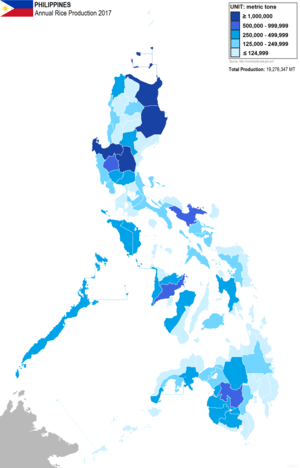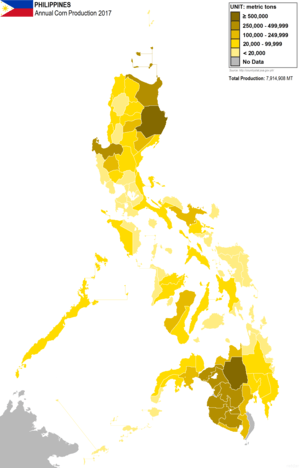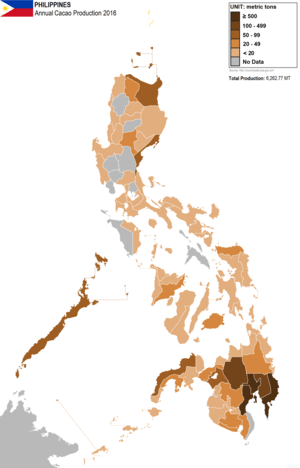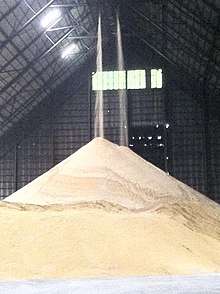Agriculture in the Philippines
Agriculture in the Philippines employs 27.7% of the Filipino workforce as of 2017, according to the World Bank [1]
Rice
The Philippines is the 8th largest rice producer in the world, accounting for 2.8% of global rice production.[2] The Philippines was also the world's largest rice importer in 2010.[3] In 2010, nearly 15.7 million metric tons of palay (pre-husked rice) were produced.[4] In 2010, palay accounted for 21.86% percent of gross value added in agriculture and 2.37% of GNP.[5] Self-sufficiency in rice reached 88.93% in 2015.[6]
Rice production in the Philippines has grown significantly since the 1950s. Improved varieties of rice developed during the Green Revolution, including at the International Rice Research Institute based in the Philippines have improved crop yields. Crop yields have also improved due to increased use of fertilisers. Average productivity increased from 1.23 metric tons per hectare in 1961 to 3.59 metric tons per hectare in 2009.[2]
Harvest Yields have increased significantly by using foliar fertilizer (Rc 62 -> 27% increase, Rc 80 -> 40% increase, Rc 64 -> 86% increase) based on PhilRice National Averages.
The table below shows some of the agricultural products of the country per region.[7]
| Region | Rice | Corn | Coconut | Sugarcane | Pineapple | Watermelon | Banana |
|---|---|---|---|---|---|---|---|
| Ilocos Region | 1,777,122 | 490,943 | 39,463 | 19,512 | 197 | 26,936 | 43,164 |
| Cordillera (CAR) | 400,911 | 237,823 | 1,165 | 51,787 | 814 | 141 | 26,576 |
| Cagayan Valley | 2,489,647 | 1,801,194 | 77,118 | 583,808 | 35,129 | 7,416 | 384,134 |
| Central Luzon | 3,304,310 | 271,319 | 167,737 | 678,439 | 1,657 | 7,103 | 58,439 |
| NCR | 0 | 0 | 0 | 0 | 0 | 0 | 0 |
| CALABARZON | 392,907 | 64,823 | 1,379,297 | 1,741,706 | 88,660 | 2,950 | 96,306 |
| MIMAROPA | 1,081,833 | 125,492 | 818,146 | 0 | 448 | 3,192 | 168,299 |
| Bicol Region | 1,264,448 | 243,908 | 1,105,743 | 239,010 | 130,595 | 5,598 | 76,452 |
| Western Visayas | 1,565,585 | 213,362 | 294,547 | 1,682,940 | 12,687 | 83,336 | 200,222 |
| Negros Island Region | 557,632 | 185,747 | 274,315 | 13,440,259 | 9,468 | 546 | 157,974 |
| Central Visayas | 269,801 | 101,333 | 274,069 | 241,573 | 998 | 1,161 | 126,220 |
| Eastern Visayas | 955,709 | 91,145 | 1,165,867 | 179,363 | 7,186 | 670 | 227,223 |
| Zamboanga Peninsula | 661,775 | 220,180 | 1,682,121 | 107 | 1,657 | 638 | 281,856 |
| Northern Mindanao | 725,120 | 1,216,301 | 1,851,702 | 3,065,463 | 1,468,386 | 2,024 | 1,832,173 |
| Davao Region | 441,868 | 224,100 | 2,246,188 | 208,743 | 26,880 | 1,070 | 3,455,014 |
| SOCCSKSARGEN | 1,291,644 | 1,239,275 | 1,159,818 | 680,383 | 794,334 | 2,132 | 1,159,091 |
| CARAGA Region | 653,431 | 118,774 | 804,722 | 0 | 2,682 | 3,010 | 259,738 |
| ARMM | 488,215 | 673,036 | 1,393,168 | 113,343 | 921 | 80 | 531,048 |



Sugar
There are at least 19 provinces and 11 regions that produce sugarcane in the Philippines. A range from 360,000 to 390,000 hectares are devoted to sugarcane production. The largest sugarcane areas are found in the Negros Island Region, which accounts for 51% of sugarcane areas planted. This is followed by Mindanao which accounts for 20%; Luzon by 17%; Panay by 07%; and Eastern Visayas by 04%.[8][8] It is estimated that as of 2012, the industry provides direct employment to 700,000 sugarcane workers spread across 19 sugar producing provinces.[9]
Sugar growing in the Philippines pre-dates colonial Spanish contact.[10] Sugar became the most important agricultural export of the Philippines between the late eighteenth century and the mid-1970s.[10] During the 1950s and 60s, more than 20 percent income of Philippine exports came from the sugar industry.[10] Between 1913 and 1974, the Philippines sugar industry enjoyed favoured terms of trade with the US, with special access to the protected and subsidized the American sugar market.[10]
Coconuts
Coconuts plays an important role in the national economy of the Philippines. According to figures published in December 2015 by the Food and Agriculture Organization of the United Nations, it is the world's largest producer of coconuts, producing 19,500,000 tonnes in 2015.[11] Production in the Philippines is generally concentrated in medium-sized farms.[12] There are 3.5 million hectares dedicated to coconut production in the Philippines, which accounts for 25 per cent of total agricultural land in the country.[13] In 1989, it was estimated that between 25 percent and 33 percent of the population was at least partly dependent on coconuts for their livelihood. Historically, the Southern Tagalog and Bicol regions of Luzon and the Eastern Visayas were the centers of coconut production.[14] In the 1980s, Western Mindanao and Southern Mindanao also became important coconut-growing regions.[14]
Abaca
According to the Philippine Fiber Industry Development Authority, the Philippines provided 87.4% of the world's abaca in 2014, earning the Philippines US$111.33 million.[15] The demand is still greater than the supply.[15] The remainder came from Ecuador (12.5%) and Costa Rica (0.1%).[15] The Bicol region in the Philippines produced 27,885 metric tons of abaca in 2014, the largest of any Philippine region.[15] The Philippine Rural Development Program (PRDP) and the Department of Agriculture reported that in 2009-2013, Bicol Region had 39% share of Philippine abaca production while overwhelming 92% comes from Catanduanes Island. Eastern Visayas, the second largest producer had 24% and the Davao Region, the third largest producer had 11% of the total production. Around 42 percent of the total abaca fiber shipments from the Philippines went to the United Kingdom in 2014, making it the top importer.[15] Germany imported 37.1 percent abaca pulp from the Philippines, importing around 7,755 metric tons (MT).[15] Sales of abaca cordage surged 20 percent in 2014 to a total of 5,093 MT from 4,240 MT, with the United States holding around 68 percent of the market.[15]
Fruits
.jpg)
The Philippines is the world's third largest producer of pineapples, producing more than 2.4 million of tonnes in 2015.[16] The Philippines was in the top three banana producing countries in 2010, including India and China.[17] Davao and Mindanao contribute heavily to the total national banana crop.[17] Mangoes are the third most important fruit crop of the country based on export volume and value next to bananas and pineapples.[18]
Corn
Corn is the second most important crop in the Philippines. 600,000 farm households are employed in different businesses in the corn value chain. As of 2012, around 2.594 Million ha of land is under corn cultivation and the total production was 7.408 million metric tons.[19]
Rubber
There are an estimated 458,000 families dependent upon the cultivation of rubber trees. Rubber is mainly planted in Mindanao, with some plantings in Luzon and the Visayas.[20] As of 2013, the total rubber production is 111,204 tons.[21]
See also
- Emergence of agriculture in the Philippines
- Coffee production in the Philippines
- Ostrich farming in the Philippines
- Crocodile farming in the Philippines
- Federation of Free Farmers
Government:
Land reform:
- Land reform in the Philippines
- Agricultural Land Reform Code
- Department of Agrarian Reform
General:
References
- http://data.worldbank.org/indicator/SL.AGR.EMPL.ZS?locations=PH
- "2009 Crop Production Statistics". FAO Stat. FAO Statistics. Retrieved 30 March 2011.
- "Factbox - Top 10 rice exporting, importing countries". Reuters. 28 January 2011. Retrieved 30 March 2011.
- "Palay: Volume of Production by Cereal Type, Geolocation, Period and Year". CountrySTAT Database. Bureau of Agricultural Statistics. Archived from the original on 20 March 2011. Retrieved 30 March 2011.
- "Philippine economy posts 7.1 percent GDP growth". National Accounts of the Philippines. National Statistical Coordination Board. Archived from the original on 2011-04-15. Retrieved 30 March 2011.
- Authority, Philippine Statistics. "Self-Sufficiency Ratio of Selected Agricultural Commodities". countrystat.psa.gov.ph. Archived from the original on 2016-10-28. Retrieved 2016-10-28.
- "Philippine Statistics Authority: CountrySTAT Philippines". Archived from the original on 2016-10-28. Retrieved 2016-10-28.
- Master Plan For the Philippine Sugar Industry. Sugar Master Plan Foundation, Inc. 2010. p. 7.
- Master Plan For the Philippine Sugar Industry. Sugar Master Plan Foundation, Inc. 2010. pp. 4–6.
- "History". Retrieved 17 March 2015.
-
Food And Agriculture Organization of the United Nations:
Economic And Social Department: The Statistical Division Archived 2015-09-06 at the Wayback Machine - Hayami, Yūjirō; Quisumbing, Maria Agnes R.; Adriano, Lourdes S. (1990). Toward an alternative land reform paradigm: a Philippine perspective. Ateneo de Manila University Press. p. 108. ISBN 978-971-11-3096-1. Retrieved 15 November 2011.
- "Philippines to launch coconut cluster". Investvine.com. 2013-02-16. Retrieved 2013-02-22.
- Ronald E. Dolan, ed. Philippines: A Country Study. Washington: GPO for the Library of Congress, 1991.
- "PH biggest abaca exporter | Malaya Business Insight". Malaya Business Insight. June 15, 2015. Archived from the original on August 9, 2016. Retrieved October 8, 2016.
- fao.org. "Food and Agricultural commodities production > Countries by commodity > Pineapples (2013)". Retrieved 12 July 2016.
- "banana". Archived from the original on 1 December 2015. Retrieved 17 March 2015.
- "mango". Archived from the original on 28 December 2014. Retrieved 17 March 2015.
- ""Agri-Pinoy Corn Program", Republic of Philippines Department of Agriculture". da.gov.ph. Archived from the original on 2014-01-22. Retrieved 2014-01-22.
- "rubber". Archived from the original on 1 December 2015. Retrieved 17 March 2015.
- "Food and Agricultural commodities production / Countries by commodity". Retrieved May 27, 2016.
Further reading
- Jesus, Ed. C. De (1980). The Tobacco Monopoly in the Philippines: Bureaucratic Enterprise and Social Change, 1766-1880. Ateneo University Press. ISBN 9715501680. Retrieved 24 April 2014.CS1 maint: ref=harv (link)

